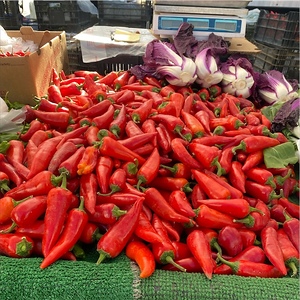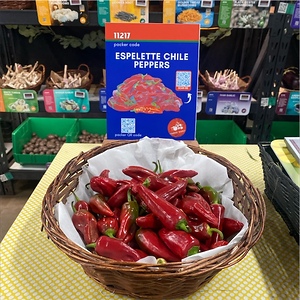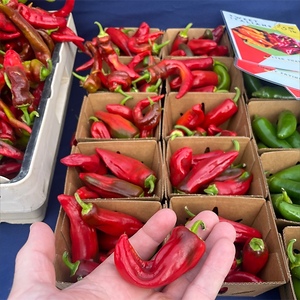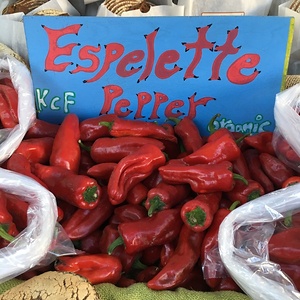

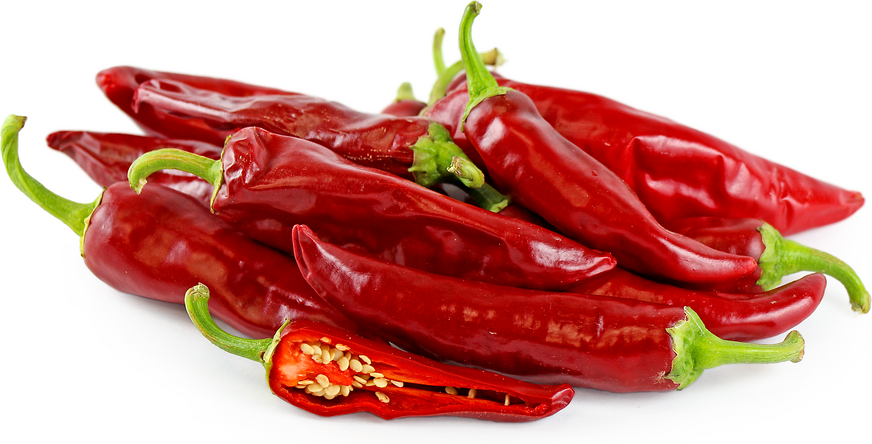
Espelette Chile Peppers
Estimated Inventory, lb : 0
This item was last sold on : 12/07/24
Description/Taste
Espelette chile peppers are vegetables with long and narrow pods, averaging 7 to 14 centimeters in length. They have an elongated, conical shape with slight tapering to a point on the non-stem end. These pods can be straight, curved, or slightly concaved. They ripen from green to deep red, with darker areas and occasional green patches, particularly near the stem. Espelette chile pepper skin is glossy, smooth, and lightly wrinkled, feeling smooth to the touch. Their red flesh encases a central cavity with thin, fleshy walls and round, flat cream-colored seeds attached to the pale membrane that runs lengthwise inside the pepper. This semi-thick flesh gives the vegetable a crunchy texture when bitten into. Espelette chile peppers have a peppery aroma and offer a bright, fruity flavor with smoky undertones and hints of citrus, balanced by a mild to medium level of heat.
Seasons/Availability
Espelette chile peppers are available in the late summer through fall.
Current Facts
Espelette chile peppers are botanically classified as Capsicum annuum and belong to the Solanaceae, or nightshade, family. This family consists of other produce like potatoes, eggplant, and tomatoes. Native to Pyrénées-Atlantiques, France, these peppers are also known as Ezpeletako Biperra in Basque and Piment d'Espelette in French. As of 2002, Espelette chile peppers were granted a protected designation of origin, also known as the French certification appellation d'origine contrôlée. This certification safeguards their unique flavor, which stems from the slightly acidic soil of the Basque region. Espelette chile peppers can vary in heat, ranging from 500 to 4,000 heat units on the Scoville scale, a unit of measurement used to indicate the spiciness of peppers. This means they can be mild to moderately spicy, depending on the stage at which they’re harvested and if they’re grown in hot and dry or cool and wet environments. Espelette chile peppers are most commonly used as a culinary ingredient in their native Basque region.
Nutritional Value
Espelette chile peppers are a source of vitamins A, C, B6, and K. These vitamins are essential for healthy vision and skin as well as immune, lung, and kidney function. They improve collagen production, iron absorption, brain function, energy levels, serotonin and dopamine production, blood clotting, and calcium regulation. This vegetable is a source of potassium to help regulate blood pressure and heart rate, muscle and nerve function, fluid balance, and encourage proper digestion. They provide the body with copper, supporting iron metabolism, tissue formation, melanin production, and preventing UV and free radical cell damage.
Applications
Espelette chile peppers can be consumed raw, roasted, baked, and sautéed. When fresh, they may be diced into sauces, salsa, and relish or chopped and tossed in salads. Fresh Espelette chile peppers can also be cooked down to make savory pepper jellies, jams, and paste. When cooked, they may be incorporated into stir-fry, pasta, soup, chili, and stew. Espelette chile peppers are popularly incorporated into pipérade, a well-known Basque sauce that cooks the Espelette pepper with onions and tomatoes. In their dried form, these peppers develop a smoky flavor similar to paprika and can be used to flavor everyday dishes. In France, dried Espelette chile powder is used in basquaise, a sauce made from peppers and tomatoes and served with vegetables, seafood, or cooked meats. Dried Espelette chile peppers can also be used to infuse oils and sea salt. Espelette chile peppers pair well with meats such as duck, ham, beef, lamb, poultry, and foie gras as well as eggs, mushrooms, tomatoes, green beans, leafy greens, goat cheese, and dark chocolate. Fresh Espelette chile peppers will keep for 1 to 2 weeks when stored whole and unwashed in a plastic bag in the refrigerator.
Ethnic/Cultural Info
On the last weekend in October, the Basque region of France celebrates the Espelette Pepper Festival. More than 20,000 visitors attend the festival, while many towns decorate their streets with garlands or festoons of Espelette peppers. The peppers are traditionally harvested and strung onto cords consisting of at least twenty peppers with the specific dates of harvest noted on the cord. Once assembled, these cords are hung from facades and balconies, as well as in households and restaurants, where the peppers can be pulled from the strings and used as needed. This celebration began in 1967 and as part of the festivities, Espelette chile peppers and other regional products are sold in the markets. Local restaurants feature the pepper on their menus in signature dishes. There are also live concerts, traditional Basque folk dances, parades, and games, all celebrating the local pepper as an emblem of the Basque culture.
Geography/History
Espelette chile peppers are descendants of the peppers native to Central and South America that were brought back to Europe by Spanish and Portuguese explorers in the 15th and 16th centuries. It's believed that Gonzalo Percaztegi, a Basque navigator sailing with Christopher Columbus, first introduced chile peppers to the Basque region, planting them with corn in the Nile Valley. Today, Espelette chile peppers are predominately grown in the Basque region of France in the communes of Espelette, Ainhoa, Cambo-Les-Bains, Halsou, Itxassou, Jatxou, Larressore, Saint-Pée-sur-Nivelle, Souraïde, and Ustaritz. Outside of France, this variety is considered a rare specialty pepper. They may be purchased from seed or specialty stores in certain areas of the United States, particularly around the Napa and Anderson Valleys of Northern California, Texas, and in Sunderland, Massachusetts where they are sold by Kitchen Garden Farms. Outside of these regions, they are more commonly found in powder form or blended into a cooking paste.



